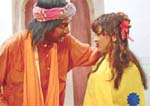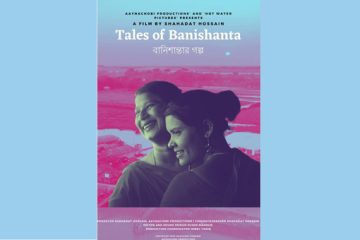Film Review
Ghetu Putro Kamola
An authentic sketch of lowlands and a dead art
 The vast lowlands in the eastern part of Bangladesh are truly enigmatic. What remain as dry land throughout the year, during monsoon these areas take a completely different look. This waterlogged state that approximately lasts for three to four months, limits mobility, thus initiating a dull state of inertia. As the proverb goes, “an idle brain is the workshop of devil”, this state of inertia initiates a strange practice in the name of recreation.
The vast lowlands in the eastern part of Bangladesh are truly enigmatic. What remain as dry land throughout the year, during monsoon these areas take a completely different look. This waterlogged state that approximately lasts for three to four months, limits mobility, thus initiating a dull state of inertia. As the proverb goes, “an idle brain is the workshop of devil”, this state of inertia initiates a strange practice in the name of recreation.
In Humayun Ahmed’s latest and last film, “Ghetu Putro Kamola”, one finds a detailed account of this strange way of life. Highlighting a cultural tradition that is now extinct — “Ghetu Gaan”, the film depicts the joys and sorrows of the inhabitants of this lowland. It is essentially a sketch of the landscape and lifestyle.
Perhaps the film became the most anticipated one in Bangladesh, in recent times, because of Ahmed’s sudden departure. Readers and audiences are hugely grateful to this remarkable storyteller for providing a detailed sketch of life in the lowlands in his numerous stories and this film.
Communal bliss, festivity, exuberance as well as dark and shocking social practices are brilliantly depicted in Ahmed’s writings; he did the same with his last project.
We have seen the mighty feudal lords in many of Ahmed’s writings and TV plays, films. We are familiar with their arrogance, their cruelty and their benevolence. Yet, when they come across as individuals, we can dissect their good and evil sides easily.
The landlord (played by Tariq Anam Khan) in “Ghetu Putro Kamola” is a helpless one.
Sometimes the landlord’s need for recreation turn into lust and the film narrates the tragic outcome of this lust. The victim, Kamola (Mamun), a young boy singing and dancing as a girl, who entertains the landlord, faces this tragedy.
We saw Ahmed’s successful depictions of landlords — portrayed by mighty actors such as Asaduzzaman Noor and Abul Hayat — before. The teaming up of another bold actor, Khan, and Ahmed could be considered the key to this film’s success.
There are representatives of conscience in the film — the big-headed but practically listless artist Shah Alam (Agun); the dance trainer of the Ghetu team (Pran Roy) and the imam of the mosque (Abdullah Rana).
Unlike his previous films such as “Aguner Paroshmoni”, “Srabon Megher Din” and “Amar Achhey Jol” which are adaptations of his literary works, Ahmed penned a brand new story for his latest film. The story is fascinating as his other works.
Some brilliant camera work, especially in the scene where Kamola is roaming around on the rooftop, playing with the landlord’s daughter, or the flashbacks, or the starting sequence — makes the film aesthetically enriched.
The cast also includes Tamalika Karmakar, Baul Abdul Kuddus Bayati and his troupe, Ani and Prapti. Shitalong Fakir’s song “Shua Urilo” has been used throughout the film as the background score, though the credits mention Ram Kanai Das as the composer. Some of Ahmed’s own compositions — such as “Jamunar Jol Dekhte Kalo” — have been sung by Fazlur Rahman Babu and Baul Shafi Mandal.
Mahfuzur Rahman Khan as director of photography, Salimullah as editor and Maqsud Jamil Mintu and SI Tutul as music directors have done well. Emon Saha directed the background music.
Produced by Impress Telefilm Ltd. and presented by Pran Jhalmuri, the film premiered at Balaka Cine World in Dhaka on September 5. The film will have its public release today, at Balaka and Star Cineplex in Dhaka.
-With The Daily Star input

